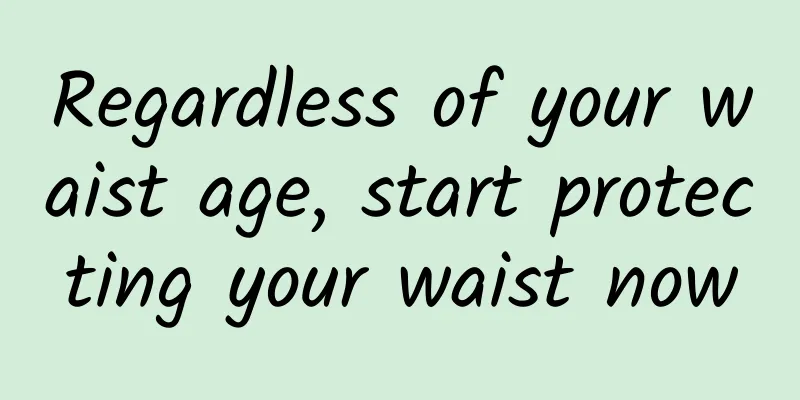Regardless of your waist age, start protecting your waist now

|
Measure your waist age 1 Can you tie your shoelaces without bending over to hold on to a wall? 2 Does your waist feel stiff when you turn over in the morning? 3. Does your waist hurt after driving for an hour continuously? 4 Can coughing and sneezing cause back pain? If 2 of the above problems occur, and 3 or more of the waist premature aging alarms occur, professional evaluation is urgently needed As an important part of the human body that bears weight and moves, the waist is easily affected by factors such as long-term sitting, bad posture, and excessive fatigue, which can lead to health problems such as lumbar muscle strain and lumbar disc herniation. Scientific daily waist protection methods can effectively prevent low back pain and delay lumbar degeneration. Waist health crisis: Your "pillar" is warning you 1. Shocking waist data (1) Age inversion: The degree of lumbar wear of a 30-year-old white-collar worker is equal to that of a 50-year-old manual laborer. (2) Pressure doubled: When you bend over to lift a 10-catties object, your lumbar spine is equivalent to carrying an adult male (about 150 catties). (3) Obesity: For every 10 catties of excess body weight, the daily wear and tear on the lumbar spine increases by 40%. 2. Common behaviors that hurt your waist (1) Office chair “torture device”: Continuous sitting for one hour causes the intervertebral disc pressure to surge by 1.5 times; the forward-leaning typing posture causes the lumbar spine load to increase by another 55%. (2) Wrong posture: When you bend over to pick up something, the pressure on your lumbar spine is equivalent to using a bamboo pole to pry a boulder; when you sit slumped over to watch a TV show, the normal curvature of your lumbar spine disappears like a steel plate. (3) Temperature attack: Blowing cold air conditioning directly at the waist can cause the blood flow rate in the waist to decrease by 30%; sitting on a heating device with a heat source (such as an electric blanket) for a long time can aggravate intervertebral disc dehydration. (4) Unilateral weight bearing: Carrying a backpack weighing more than 3 kilograms on one shoulder can increase the risk of scoliosis by 60%; crossing one’s legs while working can easily cause the pelvis to tilt, triggering a chain reaction. (5) Threat of metabolic syndrome: The rate of lumbar degeneration in diabetic patients is twice that of people without underlying diseases; tophi in people with high uric acid levels are more likely to erode lumbar joints. (6) Misconceptions about exercise: Doing sit-ups incorrectly is equivalent to hitting your lumbar spine with a hammer every day; excessive running training can cause the lumbar intervertebral disc to bear an impact force of 400 kg per step. 3. Be alert to signs that you need to see a doctor immediately Immediate medical conditions: persistent low back pain with radiating pain in the lower limbs (extending from the buttocks to the soles of the feet); development of cauda equina syndrome (incontinence, perineum numbness); waking up in pain at night, ineffectiveness of painkillers; unexplained weight loss with severe low back pain. Examination recommendations: Lumbar spine X-ray + MRI examination is the first choice for initial diagnosis; ankylosing spondylitis should be checked for long-term treatment; bone density testing is recommended for patients over 50 years old. Waist protection starts now Lumbar spine injuries are irreversible, and the water content of the intervertebral disc naturally decreases by 1% each year after the age of 30. From now on, every waist protection action is an investment in future health. 1. Scientifically select waist protection equipment 1. Protective gear selection Three factors to consider when choosing: ①Support: built-in aluminum alloy support bar to disperse lumbar pressure. ②Breathability: 3D mesh fabric to avoid heat and humidity. ③Fitness: adjustable Velcro to adapt to different waist sizes. Contraindications for use: Continuously wearing the protective gear while sleeping; relying entirely on the protective gear without exercising; blindly choosing a style that is too tight. 2. When choosing shoes, the heel height should be ≤3cm; the forefoot contact area should be ≥ the size of the palm; and the arch support area should have a noticeable bulge. 3. Choose a mattress that keeps the spine in a straight line when lying on your side, and your palm can be inserted flat into the waist gap. 2. Posture Correction Guide Sitting posture: Keep your buttocks against the chair back, and use the lumbar cushion to support the depression of the lumbar spine (a rolled towel can be used as a substitute). Standing posture: tuck in your chin → straighten your chest → tighten your abdomen → keep your pelvis in a neutral position. Lying position: When lying on your side, place a pillow between your legs to keep your spine neutral; when lying on your back, place a 10cm high pillow under your knees; Before moving objects: squat down → hold the object tightly → use your legs to stand up (keep your spine neutral). 3. Daily waist protection training 1 Fragmented training: During office breaks: stretching back in the chair (5 seconds each time x 10 times). When brushing teeth: squatting against the wall (knees should not exceed toes). When waiting for the elevator: levator ani and abdominal training (activate deep core muscles). 2 Strengthening training plan: Little Swallow Flying: Lie prone, lift your head and legs, hold for 5 seconds and then relax (10-15 times a day). Bridge exercise: Lie on your back with your knees bent, lift your hips until your shoulders, hips and knees are in a straight line (hold for 10 seconds, 10 times/set). Cat stretch: Kneel, arch your back and lower your head, then bend your waist and raise your head, dynamically stretch your spine (5 minutes each morning and evening). 4. Key points for protection in special scenarios 1 Office protection: Set up a computer stand to keep your eyes level. Use a height-adjustable desk and alternate between standing and sitting every 30 minutes. Stand up and walk around when answering a phone call to avoid tilting your head to hold the phone. 2 Sports protection: Running: Choose cushioning running shoes to reduce the impact on the lumbar spine. Swimming: When doing breaststroke, pay attention to tucking your chin and avoid tilting your head too much. Yoga: Avoid deep backbends (such as wheel pose). 3 Housework protection: Mopping the floor: Use a long-handled mop, bend your knees slightly and keep your back straight. Washing dishes: Open the cupboard and step on the mat with one foot to reduce the pressure on your waist. Holding a baby: Use the "airplane hold" posture and support with your core strength. |
<<: Snoring makes you sleep better! Such rumors should be dispelled
>>: Urticaria is common in spring. How to get rid of it?
Recommend
The discharge below is like tofu dregs
Whether the secretions from a woman's private...
What are the dangers of pelvic effusion?
Pelvic inflammatory disease can cause pelvic effu...
How many months of pregnancy is it best to do Down syndrome screening
In daily life, many babies suffer from Down syndr...
Learn some life tips to reduce your oil intake
Many chefs are used to adding a little more oil t...
Revealing the secrets of craniotomy, is it really as scary as imagined?
Author: Pan Pengwei, The First Affiliated Hospita...
What can I eat to maintain my ovaries?
The ovaries are important female organs and direc...
Will my belly hurt when I'm pregnant?
There are many symptoms during pregnancy, especia...
Silver Healing: VR Treatment for Elderly Mental Illness
Introduction: When Technology Meets Soul Imagine ...
Bacterial vaginitis but pregnant
Pregnancy is very common. For women, a normal pre...
Popular Science | How can elderly people with swallowing dysfunction eat safely? Keep these 5 tips in mind
"Unchewable rice cakes", "unswallo...
Why can't I get pregnant without using contraception?
Some people get pregnant in one go, but some peop...
Causes of reduced menstrual flow
Menstrual disorders and irregular menstrual flow ...
Why do women feel back pain after sex?
Many women will feel back pain after having sex, ...
What should I eat if my period is early and there is a lot of blood clots?
Some women sometimes experience early menstruatio...
How to treat uterine polyps
Uterine polyps are a common gynecological disease...









